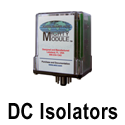Copyright © 2011 Citel Inc. USA, Used with permission
Data Line Surge Protection Overview
Introduction
Telecommunication and data transmission devices (PBX, modems, data terminals, sensors, etc…) are increasingly more vulnerable to lightning induced voltage surges. They have become more sensitive, complex and have an increased vulnerability to induced surges due to their possible connection across several different networks. These devices are critical to a company’s communications and information processing. As such, it is prudent to insure them against these potentially costly and disruptive events. A data line surge protector installed in-line, directly in front of a sensitive piece of equipment will increase their useful life and maintain the continuity of the flow of your information.
Technology of Surge Protectors
All Citel telephone and data line surge protectors are based on a reliable multistage hybrid circuit that combines heavy duty Gas Discharge Tubes (GDTs) and fast responding Silicon Avalanche Diodes (SADs). This type of circuit provides,
• 5kA Nominal Discharge Current (15 times without destruction per IEC 61643)
• Less than 1 nanosecond response times
• Fail-safe disconnection system
• Low capacitance design minimizes signal loss
Parameters for Selecting A Surge Protector
To select the correct surge protector for your installation, keep the following in mind :
• Nominal and Maximum Line Voltages
• Maximum Line Current
• Number of Lines
• Data Transmission Speed
• Type of Connector (Screw Terminal, RJ, ATT110, QC66)
• Mounting (Din Rail, Surface Mount)
Installation
To be effective, the surge protector must be installed in accordance with the following principles.
• The ground point of the surge protector and of the protected equipment must be bonded.
• The protection is installed at the service entrance of the installation to divert impulse current as soon as possible.
• The surge protector must be installed in close proximity, less than 90 feet or 30 meters) to protected equipment. If this rule cannot be followed, secondary surge protectors must be installed near to the equipment.
• The grounding conductor (between the earth output of the protector and the installation bonding circuit) must be as short as possible (less than 1.5 feet or 0.50 meters) and have a cross sectional area of at least 2.5 mm squared.
• The earth resistance must adhere to the local electrical code. No special earthing is necessary.
• Protected and unprotected cables must be kept well apart to limit coupling.
STANDARDS
Test Standards and installation recommendations for communication line surge protectors must comply with the following standards :
• UL497B : Protectors for Data Communications and Fire-Alarm Circuits
• IEC 61643-21 : Tests of Surge Protectors for Communication Lines
• IEC 61643-22 ; Choice/Installation of Surge Protectors for Communication Lines
• NF EN 61643-21 : Tests of Surge Protectors for Communication Lines
• Guide UTE C15-443 : Choice/Installation of Surge Protectors
Special Conditions : Lightning Protection Systems
If the structure to be protected is equipped with a LPS (Lightning Protection System), the surge protectors for telecom or data lines that are installed at the buildings service entrance need to be tested to a direct lightning impulse 10/350us wave form with a minimum surge current of 2.5kA (D1 category test IEC-61643-21).
For a pdf copy of this post click here.


